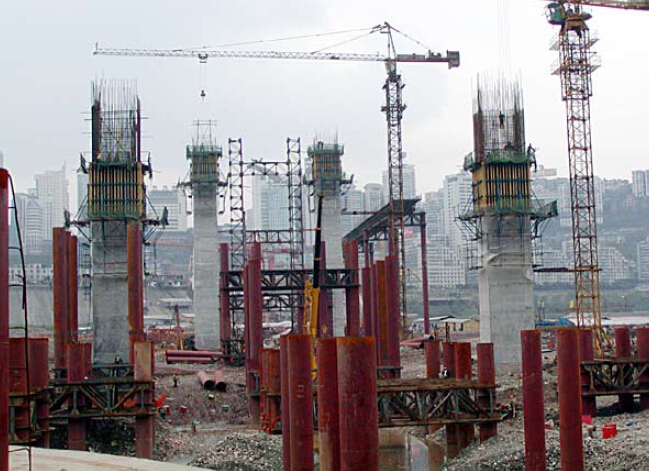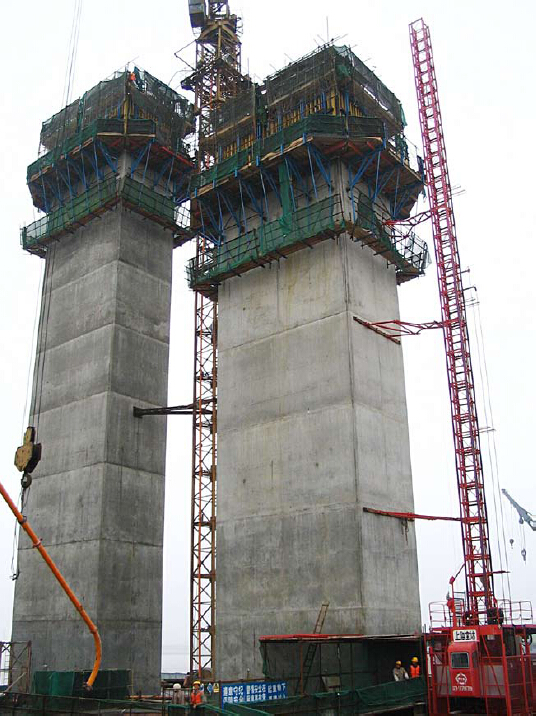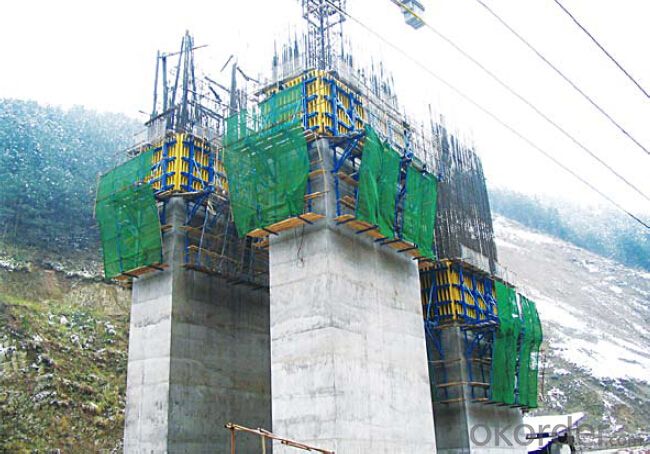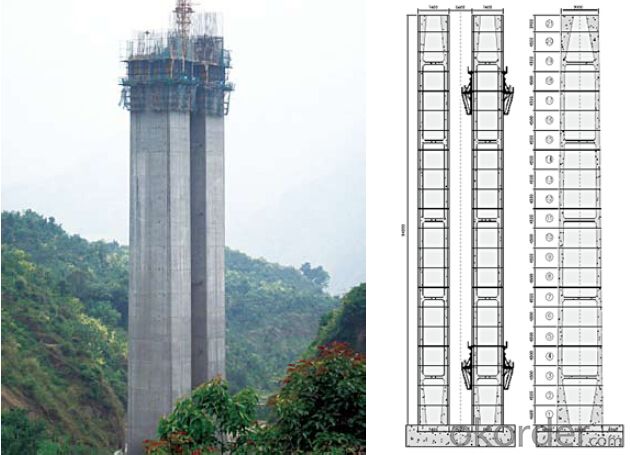Climbing Bracket CB240 for Formwork and Scaffolding systems
- Loading Port:
- Tianjin
- Payment Terms:
- TT OR LC
- Min Order Qty:
- 50 m²
- Supply Capability:
- 1000 m²/month
OKorder Service Pledge
OKorder Financial Service
You Might Also Like
Climbing Bracket CB240 & CB210
They are framework brackets for supporting large-area wall formwork.
Typical applications for the CB240&CB210 are pier and column/shear wall/core walll/ in the
building.
CB210 has smaller size than CB240, it will be cost effective in some condition.
Characteristics:
◆ High bearing capacity
The high loading capacity of the brackets allow very large scaffold units. This saves the number
anchor points required as well as reducing climbing times.
◆ Simple moving procedure by crane
Through the strong connection of formwork together with the climbing scaffold, both can be moved
as a single climbing unit by crane. Thus valuable time-savings can be achieved.
◆ Fast striking process without a crane
With the retrusive set, large formwork elements can also be retracted quickly and a minimum of
effort.
◆ Safe with work platform
The platforms have assembled firmly with bracket and will be climbing together, without scaffolding
but can work safely in spite of your high location.


- Q: Can steel formwork be used for tunnel construction projects?
- Yes, steel formwork can be used for tunnel construction projects. Steel formwork is highly durable and can withstand the high pressures and harsh conditions typically encountered in tunnel construction. It provides a strong and stable structure for pouring and shaping concrete, ensuring the tunnel's structural integrity. Steel formwork is also reusable, making it a cost-effective and efficient choice for tunnel construction projects.
- Q: What are the common challenges when using steel formwork?
- When utilizing steel formwork in construction projects, there are several common challenges that may arise. To begin with, the initial cost of steel formwork is a significant obstacle. Unlike timber or plywood formwork, steel formwork tends to be more expensive. This can pose difficulties for contractors or builders operating on limited budgets or undertaking smaller-scale projects. Another challenge is the weight of steel formwork. Being a heavy material, transporting and handling steel formwork can be physically demanding. This necessitates additional labor and equipment to safely and efficiently maneuver and position the formwork on-site. Durability is also a concern when employing steel formwork. Although steel is generally strong and long-lasting, it is vulnerable to rust and corrosion if not adequately protected. Regular maintenance and protective coatings are necessary to ensure the longevity and performance of steel formwork. Furthermore, the versatility of steel formwork can present challenges. Typically prefabricated and designed for specific applications, modifying the steel formwork to meet new requirements during the construction process can prove difficult. This may result in delays or additional costs. Lastly, the assembly and disassembly of steel formwork can be complex. These systems often require skilled labor and specific tools for installation and removal. This adds complexity to the construction process and may necessitate extra time and resources. Overall, while steel formwork offers numerous advantages in terms of strength and durability, it also presents challenges relating to cost, weight, durability, versatility, and assembly. These challenges should be carefully considered and addressed to ensure the successful utilization of steel formwork in construction projects.
- Q: Can steel formwork be used for precast concrete tanks?
- Yes, steel formwork can be used for precast concrete tanks. Steel is a popular choice for formwork due to its strength, durability, and versatility. It provides the necessary support and shape for the concrete to be poured and cured, ensuring that the tank has the desired dimensions and structural integrity. Steel formwork can be designed and fabricated to meet the specific requirements of precast concrete tanks, allowing for precise and efficient construction. Additionally, steel formwork can be reused multiple times, making it a cost-effective solution for precast concrete tank production.
- Q: What are the different surface finishes available for steel formwork?
- There are several different surface finishes available for steel formwork, depending on the specific requirements and preferences of the project. 1. Smooth finish: This is the most common surface finish for steel formwork. It involves grinding or sanding the surface to create a smooth and even appearance. Smooth finishes are ideal for projects that require a high level of precision and aesthetic appeal. 2. Textured finish: Some projects may require a textured surface finish for better bonding with concrete. This can be achieved through various methods, such as shot blasting or using textured form liners. Textured finishes provide additional grip and can enhance the bond between the formwork and concrete. 3. Brushed finish: Brushed finishes involve using wire brushes or abrasive pads to create a slightly rougher surface. This finish is often chosen for applications where slip resistance is important, such as on ramps or walkways. 4. Etched finish: Etching is a chemical process that creates a matte or patterned finish on steel formwork. This finish is commonly used for decorative purposes, as it can create unique designs or patterns on the surface. 5. Galvanized finish: Galvanizing is a coating process that involves applying a layer of zinc to the steel formwork. This finish provides excellent corrosion resistance, making it suitable for projects in harsh or corrosive environments, such as marine or industrial applications. 6. Powder-coated finish: Powder coating is a durable and decorative finish that involves applying a dry powder to the steel formwork and then curing it with heat. This finish is available in a wide range of colors and provides excellent resistance to impact, chemicals, and UV radiation. It's important to consider the specific requirements of the project, such as durability, aesthetics, and environmental conditions, when selecting the appropriate surface finish for steel formwork. Consulting with a structural engineer or formwork supplier can help determine the best finish for the intended application.
- Q: What are the different types of finishes available for steel formwork panels?
- Steel formwork panels offer a range of finishes, each with its own advantages and uses. 1. The smooth finish is the most commonly used for steel formwork panels. It ensures a clean and precise concrete surface, making it perfect for projects that require high-quality results, such as architectural structures or exposed concrete elements. 2. Textured finishes provide decorative or non-slip surfaces on the steel formwork panels. They can be achieved through methods like brushing, sandblasting, or applying textured coatings. These finishes are commonly used for pedestrian walkways, ramps, or areas that require good traction. 3. Patterned finishes add a unique aesthetic appeal to the concrete surface. They can be achieved by incorporating patterns or designs into the steel formwork panels, such as stamped or embossed patterns. Patterned finishes are often used in decorative applications like building facades, retaining walls, or interior wall panels. 4. Coated finishes involve the application of a protective coating to the steel formwork panels. This can be a paint or a specialized protective material like epoxy or polyurethane. Coated finishes provide added durability, corrosion resistance, and weather resistance, making them suitable for long-term use in harsh environments. 5. Polished finishes involve polishing the steel formwork panels to create a reflective surface. This type of finish is commonly used in architectural or decorative applications when a high-gloss, mirror-like appearance is desired. Polished finishes enhance the aesthetics of the concrete surface and create a visually striking effect. When choosing the finish for steel formwork panels, it is important to consider the specific requirements of the project, including surface quality, functionality, and aesthetics. Factors like durability, maintenance ease, cost, and environmental impact should also be taken into account.
- Q: What are the typical deflection limits for steel formwork systems?
- The deflection limits of steel formwork systems can vary depending on various factors, such as the project's specific design and application requirements. However, there are commonly followed general guidelines. In most cases, the deflection limits for steel formwork systems are determined based on the span length and the applied load. Typically, deflection limits are restricted to L/360 or L/240, where L represents the span length of the formwork. For instance, if the formwork's span length is 10 feet, the deflection limit would be L/360, which is approximately 0.028 feet or 0.34 inches. This means that the maximum allowable deflection for this formwork system would be 0.34 inches, ensuring stability and minimal deformation under the load. It should be noted that these deflection limits may be adjusted according to project requirements or industry standards. In high-rise construction projects, stricter deflection limits may be enforced to ensure the formwork system's structural integrity and overall safety. Ultimately, careful consideration and evaluation of deflection limits are necessary during the design and construction process of steel formwork systems. Consulting a structural engineer or referring to relevant industry standards can provide more accurate and specific deflection limits for a given system.
- Q: Can steel formwork be used in high-rise construction projects?
- Indeed, high-rise construction projects can benefit from the utilization of steel formwork. With its versatility and durability, steel formwork proves to be an excellent choice for constructing concrete structures, especially in the realm of high-rise buildings. This option boasts various advantages, such as its exceptional strength, remarkable dimensional stability, and its ability to endure heavy loads and pressure. Moreover, steel formwork guarantees a smooth finish to the concrete surface and promotes environmental sustainability by allowing for easy reusability. Consequently, this minimizes material wastage and effectively reduces project costs. Furthermore, the adaptability of steel formwork systems enables customization to meet the specific requirements of high-rise construction projects, ultimately ensuring efficient and precise construction processes.
- Q: Can steel formwork be used for projects with limited formwork storage space?
- Yes, steel formwork can be used for projects with limited formwork storage space. Steel formwork is known for its durability and reusability, making it a preferred choice for projects with limited storage space. Unlike traditional timber formwork, steel formwork can be easily dismantled and stored in a compact manner, allowing for efficient use of limited storage space. Additionally, steel formwork can be quickly assembled and disassembled, reducing the time and effort required for formwork installation and removal. Overall, steel formwork is a suitable option for projects with limited formwork storage space due to its compact storage capabilities and easy handling.
- Q: What are the different types of form release agents used with steel formwork?
- There are several different types of form release agents that can be used with steel formwork. These agents are applied to the surface of the formwork before pouring concrete to prevent it from sticking to the steel and to facilitate easy removal of the formwork once the concrete has cured. 1. Petroleum-based form release agents: These are the most commonly used type of form release agents for steel formwork. They are made from petroleum oils and contain additives to enhance their performance. These agents provide a thin film on the surface of the steel, preventing the concrete from adhering to it. 2. Water-based form release agents: These agents are an alternative to petroleum-based ones and are preferred by some due to their environmentally-friendly nature. They are composed of water, emulsifiers, and additives that provide a barrier between the steel and concrete. Water-based agents are less volatile than petroleum-based ones and are easy to clean up. 3. Barrier release agents: Barrier release agents are formulated with a combination of waxes, resins, and polymers. They create a physical barrier between the steel and the concrete, preventing adhesion. Barrier release agents are useful when dealing with high-strength or self-consolidating concrete, which may have a stronger tendency to stick to the formwork. 4. Reactive release agents: These agents work by chemically reacting with the alkaline compounds in the concrete to form a soap-like film that prevents adhesion. Reactive release agents are typically used when a good bond between the formwork and the concrete is desired, such as in architectural concrete where a smooth surface finish is desired. 5. Dry release agents: Dry release agents are usually a powder or granular substance that is applied to the steel formwork. They work by absorbing moisture from the concrete, creating a barrier between the formwork and the concrete. Dry release agents are often used in situations where a liquid release agent may interfere with subsequent surface treatments, such as decorative coatings. It's important to note that the choice of form release agent depends on factors such as the type of steel formwork, the type of concrete being poured, the desired surface finish, and environmental considerations. It is recommended to consult with a professional or refer to manufacturer guidelines to select the most suitable form release agent for a specific project.
- Q: How does steel formwork handle different concrete pumping methods?
- Steel formwork offers a versatile and long-lasting solution for managing different concrete pumping methods. It is specifically designed to endure the pressure and force exerted during the pumping process, making it suitable for a range of pumping techniques. One widely used concrete pumping method involves the use of boom pumps, which employ a flexible or telescopic boom to reach the desired location. Steel formwork easily accommodates this method by providing a stable and secure surface for the boom pump to rest on. The strength and rigidity of steel ensure that the formwork remains intact and can withstand the weight and vibrations generated by the pumping process. Another popular pumping method is line pumping, which relies on a series of pipes and hoses to transport concrete to the intended location. Steel formwork is compatible with this method as well, as the pipes and hoses can be securely fastened to the formwork using clamps or brackets. The formwork acts as a support system for the pipes, ensuring they stay in place and can effectively transport the concrete without any disruptions. Furthermore, steel formwork can accommodate other concrete pumping methods like trailer-mounted pumps or truck-mounted pumps. These methods involve the use of portable pumps that can be easily moved to different locations. Steel formwork can be conveniently repositioned or adjusted to cater to the pump, providing a stable and dependable platform for the pumping process. In conclusion, steel formwork is a suitable choice for managing different concrete pumping methods due to its strength, stability, and adaptability. It effectively supports the equipment used in various pumping techniques, resulting in a seamless and efficient concrete placement process.
Send your message to us
Climbing Bracket CB240 for Formwork and Scaffolding systems
- Loading Port:
- Tianjin
- Payment Terms:
- TT OR LC
- Min Order Qty:
- 50 m²
- Supply Capability:
- 1000 m²/month
OKorder Service Pledge
OKorder Financial Service
Similar products
Hot products
Hot Searches




















